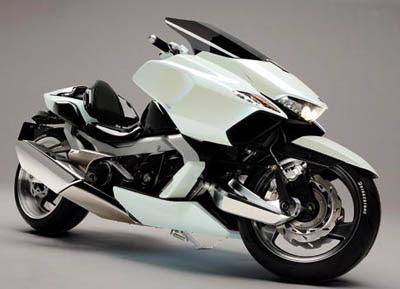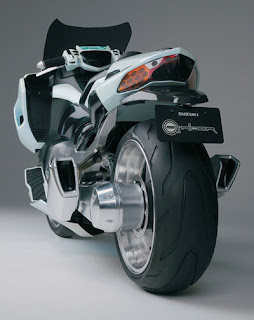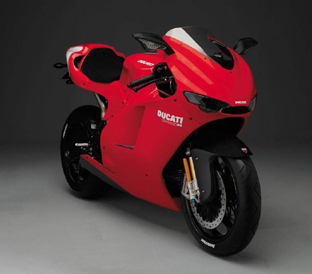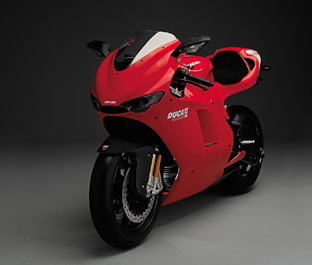 ll include a compacted combustion chamber via new domed pistons with valve cutouts. The entire powerplant has been streamlined for efficiency, with Yamaha's PR claiming that "over 50 friction-reducing strategies have been employed inside the engine, including the use of wider crank bearings." Twin-injection fuel injection is utilized to improve fueling at high rpm, with the new R6 also being fitted with last year's headlining component on its larger R1 sibling - Yamaha Chip Controlled Intake (YCC-I). The YCC-I system uses the ECU to control variable-length intake trumpets in order to deliver optimal power dependant on RPM. This system teams with the fly-by-wire YCC-T (Yamaha Chip Controlled Throttle) system, which was featured on last year's model. The 2008 R6 also holds onto one of our favorite components for a track-ready mount, a slipper clutch - the back torque-limiting design muffling the effects of abrupt downshifts on the unchanged 6-speed transmission. The big news for the '08 Yamaha is an all-new frame, swingarm and magnesium-alloy subframe. Yamaha has great things expected from the new chassis components, claiming the Deltabox aluminum frame "incorporates GP thinking in terms of engine positioning and rigidity for the ultimate in 600-class handling." Internal ribs have been added to the new swingarm, with the new unit designed to pivot high in the new frame for improved cornering stability. The magnesium subframe lightens the rear and improves the new R6's mass centralization. The four-way adjustable suspension components, a 41mm inverted fork up front and single shock out back, still provide 4.7 inches of travel. The two units have been modified, however, with both featuring increased adjustability for ride height to accommodate more rider and tire combinations. Yamaha also claims front end feedback has been fine
ll include a compacted combustion chamber via new domed pistons with valve cutouts. The entire powerplant has been streamlined for efficiency, with Yamaha's PR claiming that "over 50 friction-reducing strategies have been employed inside the engine, including the use of wider crank bearings." Twin-injection fuel injection is utilized to improve fueling at high rpm, with the new R6 also being fitted with last year's headlining component on its larger R1 sibling - Yamaha Chip Controlled Intake (YCC-I). The YCC-I system uses the ECU to control variable-length intake trumpets in order to deliver optimal power dependant on RPM. This system teams with the fly-by-wire YCC-T (Yamaha Chip Controlled Throttle) system, which was featured on last year's model. The 2008 R6 also holds onto one of our favorite components for a track-ready mount, a slipper clutch - the back torque-limiting design muffling the effects of abrupt downshifts on the unchanged 6-speed transmission. The big news for the '08 Yamaha is an all-new frame, swingarm and magnesium-alloy subframe. Yamaha has great things expected from the new chassis components, claiming the Deltabox aluminum frame "incorporates GP thinking in terms of engine positioning and rigidity for the ultimate in 600-class handling." Internal ribs have been added to the new swingarm, with the new unit designed to pivot high in the new frame for improved cornering stability. The magnesium subframe lightens the rear and improves the new R6's mass centralization. The four-way adjustable suspension components, a 41mm inverted fork up front and single shock out back, still provide 4.7 inches of travel. The two units have been modified, however, with both featuring increased adjustability for ride height to accommodate more rider and tire combinations. Yamaha also claims front end feedback has been fine -tuned courtesy of "revised outer fork tubes, a new lower triple clamp, and increased fork offset." Riding position has been adjusted, with the rider and bars moved "forward and slightly lower" and the clip-on handlebars "also lower and re-angled." Yamaha also maintains revised bodywork delivers "even greater aerodynamic efficiency." Although tweaking the chassis, the R6's steering geometry, including the 24-degree rake, 3.8-inch trail and 54.3-inch wheelbase, remains unchanged from last year. Dimensions like the 33.5-inch seat height, as well as height (43.3 inch) and length (80.3 inch), are also unchanged. The claimed dry weight for 2008 is nine pounds greater, however, with the new R6 tipping the scales at 366 lbs. In the braking department, the R6's strong stoppers retain dual 310mm rotors with radial-mount 4-piston calipers up front. The front rotors have increased in thickness, however, from 4.5mm to 5mm to improve cooling qualities. The 220mm rear disc with single-piston caliper setup remains the same. The new and improved R6 doesn't come without a cost, as the '08 model (depending on color combination) increases MSRP from $9299 to $9599. The new R6 will be available in dealers this November in Liquid Silver, Raven and Team Yamaha Blue. A special Cadmium Yellow with Flames version will be available in December with an extra $200 tacked onto the MSRP.
-tuned courtesy of "revised outer fork tubes, a new lower triple clamp, and increased fork offset." Riding position has been adjusted, with the rider and bars moved "forward and slightly lower" and the clip-on handlebars "also lower and re-angled." Yamaha also maintains revised bodywork delivers "even greater aerodynamic efficiency." Although tweaking the chassis, the R6's steering geometry, including the 24-degree rake, 3.8-inch trail and 54.3-inch wheelbase, remains unchanged from last year. Dimensions like the 33.5-inch seat height, as well as height (43.3 inch) and length (80.3 inch), are also unchanged. The claimed dry weight for 2008 is nine pounds greater, however, with the new R6 tipping the scales at 366 lbs. In the braking department, the R6's strong stoppers retain dual 310mm rotors with radial-mount 4-piston calipers up front. The front rotors have increased in thickness, however, from 4.5mm to 5mm to improve cooling qualities. The 220mm rear disc with single-piston caliper setup remains the same. The new and improved R6 doesn't come without a cost, as the '08 model (depending on color combination) increases MSRP from $9299 to $9599. The new R6 will be available in dealers this November in Liquid Silver, Raven and Team Yamaha Blue. A special Cadmium Yellow with Flames version will be available in December with an extra $200 tacked onto the MSRP.Bore x Stroke: 67.0 x 42.5mm
Compression Ratio: 13.1:1
Carburetion: Fuel Injection with YCC-T and YCC-I Ignition: TCI
Transmission: 6-speed; multiplate slipper clutch
Final Drive: Chain
Suspension/Front: 41mm inverted fork; 4-way adjustable, 4.7-in travel
Suspension/Rear: Single shock; 4-way adjustable, 4.7-in travel
Brakes/Front: Dual 310mm floating disc; radial-mount 4-piston calipers
Brake/Rear: 220mm disc; single-piston caliper
Tire/Front: 120/70-ZR17
Tire/Rear: 180/55-ZR17
L x W x H: 80.3 x 27.6 x 43.3 in
Seat Height: 33.5 in
Wheelbase: 54.3 in
Rake (Caster Angle) : 24.0 degrees
Trail: 3.8 in
Fuel Capacity: 4.6 gal
Dry Weight: 366 lb
Color: Team Yamaha Blue/White; Raven; Liquid Silver ($9599); Cadmium Yellow w/Flames ($9799)

Confidence, agility, performance... maximum excitement for maximum fun.
The engineers at Yamaha had 2 main goals for the new 2008 Yamaha R6. To be the most exciting bike to race on the track and to be the most fun sport bike to ride on a winding road. Even at full lean, the new 2008 Yamaha R6 allows the rider to dial up the throttle and sling shot out of a corner. Confidence, agility, performance and fun.
Cutting edge champion - Almost anywhere you look on the 2008 R6 you'll find something new, including YCC-I, Yamaha Chip Controlled Intake. It's bristling with loads of refinements and knowledge gained from years of racing. You can confidently say the YZF-R6 C.E. Canadian Edition is the most advanced production 600cc motorcycle Yamaha - or anybody else - has ever built.
Yamaha has re-invented the all new 2008 R6 with a showcase of Yamaha's latest sport bike technologies.
From the YCC-T fly by wire throttle to the MotoGP inspired straight frame design, to Yamaha's exclusive electronically variable intake stacks, this new R6 featuring a new engine and frame is designed to take super sport riding to a whole new level.
FEATURES:
Revised ultra-compact, lightweight, short stroke, 599cc, DOHC, 16-valve, liquid-cooled, in-line four-cylinder with lightweight titanium valves produces incredible horsepower for a 600cc engine. Redline is set at an amazing 16,000rpm.
The compression ratio has been increased from 12.8:1 to 13.1:1.
67mm bore and 42.5mm stroke provide a fast revving powerplant. Engine width is minimized thanks to Yamaha's special casting technologies and "liner less" cylinder design.
Compact "pent roof" cylinder head design features ultra lightweight titanium valves for both intake and exhaust. The intake valve angle is 11.5 degrees and the exhaust is 12.25 degress. The intake valves are 27mm in diameter while the exhaust valves are 23mm.
Single intake valve springs reduce weight and "friction" for optimum high rpm performance. The valve spring material for both the intake and exhaust has been revised to accomodate the increased power. The valve retainers are made of lightweight aluminum.
High flow intake and exhaust ports allow more fuel in and more exhaust out for great power delivery at all rpms.
Lightweight magnesium cylinder head cover and case covers reduce weight.
Separate cylinder block (the cylinder is no longer part of the upper crankcase) design utilizes ceramic composite plated "liner less" cylinder bores. The ceramic coating is sprayed directly on the aluminum block. The benefits are greater heat dissipation for consistent power delivery, reduced frictional power loss, reduced oil consumption and since there are no heavy liners, reduced weight too.
Revised lightweight forged pistons feature thin top rings for great high rpm power. The pistons are secured by lightweight tapered type piston pins. The lightweight design means fast engine response.
Revised lightweight crankshaft features 31mm bearing journals. The inertial crank mass has been optimized for excellent throttle response and impressive acceleration. The crank journal bearings feature new design oil holes that increase the supply of oil.
The connecting rod bearing width has been increased by 1mm while the rod cap has been revised to match.
Revised high lift / high performance, hollow, side-driven camshafts provide arm stretching power and strong acceleration. For 2008 the exhaust camshaft event angle has been changed from 109 to 110 degrees. The profile and lift remains the same as 2007.
The cam timing and overlap for both the intake and exhaust cams has been changed for improved engine performance.
Revised cam chain now uses a special "Vanadium carbide treatment on the pins. For durability.
Revised semi-hydraulic type cam chain tensioner reduces mechanical noise and maintenance. The "slider" that the cam chain pushes against has been changed to match the increased engine output.
Mikuni fuel injection system with 41mm throttle bodies features twin injectors (primary & secondary). This type of twin injector system is also found on our MotoGP M1 machine. Each of the injectors utilizes 12 spray holes to maximize the atomization process. The secondary injectors, located inside the airbox, begin to function at mid rpms (6,000 to 7,000rpm) thru to redline. This system is lighter and simpler than the sub motor driven secondary valve type FI system. Special short intake tracts allow for higher rpms and improved power.
The revised F.I. system features a new separate TPS (throttle position sensor) and APS (accelerator position sensor) sensors.
Yamaha Chip Control Throttle (YCC-T) is another 1st for Yamaha. This system electronically controls the throttle for outstanding response and improved controllability at high rpms. The system features Throttle Position Sensor (TPS) and D.C. motor driven throttle valves. The YCC-T system electronically controls the throttle valves for outstanding response and improved controllability at all rpms. The YCC-T is used to provide even more control of the intake air volume for a smoother torque character. The YCC-T features 3 - ECU's inside the main ECU to control ignition, fuel injection and the YCC-T. This special ECU is capable of responding to changes at a speed of 1000th of a second.
All new YCC-I or Yamaha's Chip Controlled Intake means the intake funnels / stacks vary in length based on engine rpmand throttle position. At low to mid rpms the funnels are set at 140mm and as the rpm increases, the funnels move to their shorter position (65mm) via an electric-control servo motor to provide maximum horsepower, torque and throttle response at all rpms. The range of movement is from 140mm to 65mm. The all new YCC-I provides the best of both worlds …solid low rpm performance with amazing high rpm power. YCC-I ensures that the intake tracts are "tuned" to the ideal length for the prevailing engine rpm. It takes 0.3 of a second for the funnels to move from the high position to the low position.
Revised 7.6 litre air box uses a viscous type air filter. The airbox mounting method is changed.
Ram Air Induction System with centrally located intake duct delivers cool, high-pressure air "force-fed" into the intake tract for optimal combustion and greater horsepower at higher speeds. This design provides straight induction from the central fairing duct to the airbox without a lot of bends or turns.
Close ratio 6-speed transmission delivers seamless power delivery and maximum acceleration. Gear widths, splines and engagement dogs have been optimized to handle the increased power. The shift drum and shifting mechanism are located on the right side of the cases for smooth shifting feel under power. The gears use flat contact-type engagement dogs for positive shifting and increased durability.
The "Tri-Axis" or stacked transmission design creates a more compact engine front to back that allows for optimum engine placement in the "sweet spot" of the frame for optimized balanced weight distribution and incredible handling.
Slipper or back limiter clutch assembly reduces rear wheel hop when making hard down shifts or under hard braking. Key benefit is reduced lap times and smoother control when participating in either a race or track day. This clutch uses 9 paper based friction plates and 8 steel plates, plus 6 coil-type clutch springs.
The oil lubrication system has been optimized to reduce frictional loses caused by "oil drag". It features a "two side" oil pump. There is a separate liquid-cooled oil cooler to insure consistent engine temperatures for maximum performance and extended service life.
High capacity cooling system features a curved radiator with dual ring-type fans for excellent engine cooling efficiency. The ring-type fan offers more airflow than a conventional type fan.
Direct ignition coils, iridium dual electrode spark plugs and high-output magneto deliver reliable, super strong spark. With this system, the ignition coils are integrated into the plug caps, significantly reducing weight.
4-into-2-into-1 exhaust maximizes engine performance. There are three, 3-way honeycomb catalyziers with an oxygen sensor in the system to reduce harmful HC & CO exhaust emissions. The oxygen sensor provides feedback to the ECU so it can adjust for the optimum fuel/air mixture. A "mid ship" MotoGP style, lightweight titanium muffler is located below the engine to central mass and lower the center of gravity.
The exhaust system also features Yamaha's EXUP System (Exhaust Ultimate Power Valve) utilizing a titanium body and butterfly valves that prevent the "blow back" phenomenon caused by "valve overlap". This design reduces weight and maximizes cornering clearance. The EXUP system eliminates "flat spots" in the power band and reduces emissions too. This is a 1st on a 600cc supersport machine.
High powered 32 bit electronic control unit actually contains three ECUs inside the main ECU to control the FI system, the YCC-T system and the ignition system.
Air Injection System (AIS) injects fresh air into the exhaust ports to fully burn any unburnt fuel in order to reduce harmful CO & HC exhaust emissions
New compact, lightweight aluminum Deltabox frame offers an optimized total rigidity balance for incredibly light and agile handling. This frame is a MotoGP inspired innovation that Yamaha calls a "straight frame concept". This means the top spars of the frame lie as close to possible to the frame's torsional axis (the line connecting the head pipe to the swingarm pivot point). The ram air duct passes through the frame at the head pipe for a straight ram air effect too. A mix of revised mold castings and pressed aluminum plates make up the frame. The engine is a fully stressed chassis member allowing for a super-light frame design. Although the frame may look similar to the 2007 version, the outer panel shape has been changed, the front cross member has been eliminated, and the overall rigidity balance is improved for even more precise and agile handling.
New, detachable magnesium rear subframe reduces weight. The detachable design allows rear shock access and is less costly if the unit is "looped out".
Revised lightweight, aluminium "gull wing" type swingarm uses a mix of castings and pressed plates for optimum rigidity. The swingarm pivot area has been modified for increased rigidity. The swingarm pivot position has also been optimized to reduce the "squat" tendencies caused by drive chain reaction to hard throttle openings.
Key chassis geometry figures include: 1380mm wheelbase, 24 degree caster angle, 97mm of trail and a 52.5% front and 47.5% rear weight balance. The maximum lean angle is a knee scraping 57 degrees.
The riding position has been changed for 2008. The seat is 5mm further forward than in '07.
Revised fully adjustable 41mm inverted front fork provides 120mm (4.7") of wheel travel and offers incredible suspension performance with ultra-precise feedback. The outer tubes of the fork have been optimized. Adjustments include: spring preload, 4-way high speed compression damping, 20-way low speed compression damping and 25-way rebound damping. The inverted design not only reduces unsprung weight but also increases the rigidity of the fork. The range of adjustments allows the rider to tune suspension to match riding style and conditions.
Upper triple clamp features a 30mm offset for precise handing and great steering feel. The lightweight aluminum clip-ons are mounted below the triple clamp.
Revised fully adjustable Monocross link rear suspension utilizes a newpiggyback-style shock providing 120mm (4.7") of wheel travel. Shock adjustments include: 9 steps of spring preload adjustability, 20-way high speed compression damping, 4 -way low speed compression damping and 20-way rebound damping adjustability. The piggy back design helps to keep the shock oil cool for more consistent damping. The new shock reduces weight.
Rear ride can height can be adjusted if desired.
The lower triple clamp has been revised to optimize the rigidity balance for razor sharp handling.
Revised radial mount, monoblock, 4-piston calipers squeeze large 310mm dual front discs. The thickness of the discs has been increased by 0.5mm to 5mm for improved heat dissipation. The radial mounting design helps to reduce caliper distortion for improved braking performance with excellent control and good lever feedback. The disc carriers are made from aluminium for reduced weight while the sinter metal pads provide incredible stopping power.
Brembo radial pump master cylinder features a 16mm piston. The radial design allows for more powerful braking and improved lever feedback. The lever is adjustable for various hand sizes.
Light weight 220mm rear disc brake is squeezed by a single-piston caliper
Lightweight five-spoke 17" wheels reduce unsprung weight by making hub and spokes a single structural unit. A special casting technique makes the rim section substantially lighter and stronger.
Revised ultra-sleek "new edge form" bodywork features a sharp front profile with centrally located Ram Air duct, engine-revealing side cowlings and ultra-sleek tail section. There are special side fairing intake ducts to allow cool air to circulate around the engine, fuel tank and frame areas. "Minimalism" and "mass forward" movement are two words that best describe this new design body.
The seat area and tail section have been revised for improved appearance.
17.5-litre fuel tank provides excellent rider ergonomics and an aggressive riding position. The reserve portion of the tank is 3.5 liters. The tank features a front tank cover like the R1 and an internal electric fuel pump.
Separate rider and passenger seats. An optional rear seat cowl is available.
Revised dual 55 watt H7 "cat eye" headlights. The lens shape has been changed for improved appearance. These lights not only cast a bright beam of light, but also feature a sleek profile for superb aerodynamics.
Revised compact race inspired multi-function digital and analog instrumentation with adjustable back lighting. Features: analog tach, digital speedometer, dual tripmeters, low fuel warning light, fuel tripmeter, and clock. There is also a programmable shift light and stop watch/lap timer that is controlled by the LHS handlebar mounted switch gear. The tach face has been changed for improved appearance.
Revised single lens LED taillight provides excellent visibility, extended service life and uses less power than conventional bulbs. The lens shape has been changed for improved appearance.
Immobilizer ignition system is designed to reduce the possibility of "ride away" theft. This system must recognize the "coded ignition key" in order for the unit to start. If the immobilizer ignition does not recognize the key (or a theft's screwdriver or other type of "jimmy tool") the bike will not start even if the ignition is turned or forced into the on position. If the system does not recognize the correct coded ignition key, the ignition system and starter will not function.
Durable, lightweight, aluminum clip-on bars provide optimal vibration damping.
Adjustable front brake lever
New design mirrors
Special 525 lightweight O-ring chain is used to reduce weight
Steering lock
Lightweight aluminum side stand and chain adjusters
Lightweight low maintenance sealed gel-type battery
White and red paint scheme
Special Canadian Edition logo on fuel tank
The YZF-R6 offers a significant level of power and performance. It is not intended for novice or inexperienced riders.
SPECIFICATIONS USA - 2008 Yamaha YZF-R6 C.E. Canadian Edition:
MSRP* Not Available in the USA
SPECIFICATIONS Canada - 2008 Yamaha YZF-R6 C.E. Canadian Edition:
Suggested Retail $12,599 CDN
Engine Liquid-cooled, DOHC, 16-valve (titanium), in-line four
Displacement 599 cc
Bore and Stroke 67 x 42.5 mm
Compression Ratio 13.1:1
Maximum Torque 6.7 kg-m (48.5 ft-lb) @ 10,500 rpm
Fuel Delivery 41 mm Mikuni throttle body F.I.
Lubrication Wet sump
Ignition Digital TCI
Transmission 6 speed
Final Drive O-ring Chain
Suspension (Front) Fully adjustable 41 mm inverted cartridge fork
Suspension (Rear) Fully adjustable link Monocross
Brakes (Front) Dual 310 mm discs
Brakes (Rear) 220 mm disc
Tires (Front) 120/70 ZR17
Tires (Rear) 180/55 ZR17






















